Sauna and Herbal Steam Methods to Promote Health
Saunas or steam baths are the oldest form of relaxation therapies; they promote blood circulation, open the airways, enhance sweating and mucosal secretions, and regulate the immune-modulating effect. In TCM understanding, the heat and moisture not only promotes bodily functioning, but also lubricates the body and regulates internal water metabolism. Having saunas or steam baths regularly helps to harmonize the inner and outer aspects of the body and calms the spirit as well.
Recommended procedures are:
Wash and clean the body properly, and wipe with a towel. Enter the hot room for the first round; lay down or sit and change posture constantly so that the body can receive heat evenly. You can use a whisk to stimulate the blood flow on the body surface and promote ventilation around the body. This round usually takes 7 to 15 minutes. Leave the hot room when you feel hot enough and cool off by taking a shower or dipping in water or just by sitting in room temperature or outdoors. After a 10-minute break, dry the body and enter the hot room again. Repeat the hot-cold cycle 2 to 5 times, as long as you feel comfortable.
When taking a sauna or steam bath, the temperature, humidity and time spent in the sauna or steam bath should be calculated according to individual's condition. A healthy person can stay in a dry hot room (20〜40% humidity, 80〜90℃) for about 17 minutes on average, while in wet hot room (80〜100% humidity, 40〜50℃) for about 19 minutes. During the cooling off period, watch out not to get cold as the body is in a more "sensitive" state than normal; TCM suggests ending the procedure by washing the feet with warm water. After the bath, rest for at least half an hour, have a refreshing drink and a salty snack. Saunas or steam baths can be taken weekly; allocate at least 1.5 and 2.5 hours for saunas or steam baths.
Athletes are suitable to take sauna or steam bath after exercise, but not suggested one or two days before training or competition. For those who have acute or infectious conditions, epilepsy, respiratory and cardiovascular diseases, diabetes, hyperparathyroidism, kidney problem, tumors and bleeding tendency are not recommended for this method.
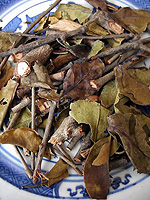 Mulberry mistletoes |
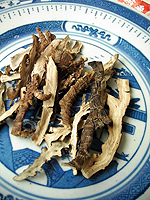 Acorus |
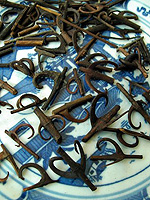 Gambir vine stem |
The tradition of steam bathing has existed over thousand years in China; people like to add various herbs for health promotion or for certain therapeutic effects. The selected herbs are mostly used for opening the skin pores to expel pathogens on the exterior body, promoting meridian flow to arrest pain or itchiness.
For health promotion or general medical conditions, herbal steaming is operated in a properly equipped room, so that the ventilation, temperature and humidity can be properly controlled. Each time, four to eight ingredients are selected to decoct as a prepared solution, for example:
- Insomnia: mulberry mistletoes, acorus, fresh tangerine peel, lavender, albizia flower, chrysanthemum, lily flower, and jasmine.
- Mental stress: white peony root, selfheal fruit spike, Chinese senega, lily bud, gambir vine stem and silktree albizzia bark.
- Obesity: rose bud, mulberry leaf, Sichuan lovage, lotus leaf, giant knotweed rhizome, rice paper plant pith , myrrh finger citron fruit and tangerine peel.
- Common cold or flu with chills and a runny nose: ephedra, cassia twig, fresh ginger, perilla leaf and liquorice root.
- Summer heat: honeysuckle flower, forsythia capsule, baical skullcap root, isatis root, leaf of Henon Bamboo, peppermint, sandalwood and dyers woad leaf.
Steam bathing method is also beneficial to many skin problems too, if proper herbs are selected according to syndrome differentiation.
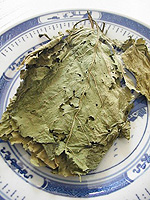 Mulberry leaf |
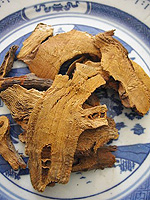 Giant knotweed rhizome |
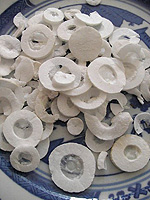 Ricepaper plant pith |
On the other hand, partial steaming method is mostly applied as a rehabilitation therapy for bone and traumatic injuries. It is an easy application that can be done at home, and usually employed in conjunction with washing or soaking. Special herbs are selected according to affected lesions, e.g.
1. Neck pain or stiffness:
| qiang huo | notopterygium Root | Rhizoma seu Radix Notopterygii |
| du huo | pubescent angelica root | Radix Angelicae Pubescentis |
| fang feng | ledebouriella root | Radix Ledebouriellae |
| chuan xiong | Sichuan lovage | Rhizoma Ligustici Chuanxiong |
| hong hua | safflower | Flos Carthami |
| yan hu suo | corydalis Rhizome | Rhizoma Corydalis |
| su mu | sappan wood | Lignum Sappan |
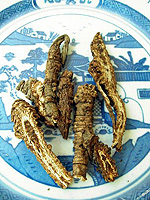 Notopterygium Root |
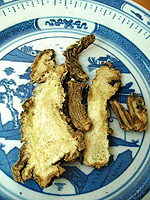 Double-teeth pubescent angelica root |
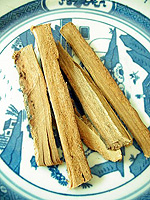 Erythrina bark |
2. Shoulder region that involves soft tissue, tendons and joints problems:
| hai tong pi | erythrina bark | Cortex Erythrinae |
| tou gu cao | garden balsam stem | Herba Speranskia tuberculatae |
| ru xiang | frankincense | Olibanum |
| mo yao | myrrh | Resina Commiphorae Myrrhae |
| dang gui | angelica root | Radix Angelicae Sinensis |
| hong hua | safflower | Flos Carthami |
| fang feng | ledebouriella root | Radix Ledebouriellae |
| bai zhi | dahurian angelica root | Radix Angelicae Dauhuicae |
3. Lumbar region that involves muscular strain, sprain, vertebra or disc problems:
| du huo | pubescent angelica root | Radix Angelicae Pubescentis |
| qin jiao | Large-leafed gentian | Radix Gentianae Macrophyllae |
| chuan niu xi | cyathula root | Radix Cyathulae |
| xi xin | Manchurian wildginger | Herba Asari |
| yan hu suo | corydalis rhizome | Rhizoma Corydalis |
| chuan xiong | Sichuan lovage | Rhizoma Ligustici Chuanxiong |
4. Upper limbs that involves sprains, fractures or dislocations:
| shen jin cao | common clubmoss herb | Herba Lycopodti |
| tou gu cao | garden balsam stem | Herba Speranskia tuberculatae |
| jing jie | schizonepeta herb | Spica Schizonepetae |
| hong hua | safflower | Flos Carthami |
| su mu | sappan wood | Lignum Sappan |
| liu ji nu | diverse wormwood herb | Herba artemisiae anomalae |
| gui zhi | cassia twig | Ramulus Cinnamomi |
5. Lower limbs that involves fractures, sprain and dislocations:
| shen jin cao | common clubmoss herb | Herba Lycopodti |
| hai tong pi | erythrina bark | Cortex Erythrinae |
| wu jia pi | acanthopanax bark | Cortex Radicis Acanthopanacis |
| chuan niu xi | cyathula root | Radix Cyathulae |
| mu gua | quince fruit | Fructus Chaenomelis |
| san leng | common burreed tuber | Rhizoma Spargani |
| e shu | zedoray rhizome | Rhizoma curcumae |
6. Joint problems such as osteoarthritis, rheumatic or rheumatoid arthritis:
| tou gu cao | garden balsam stem | Herba Speranskia tuberculatae |
| hong hua | safflower | Flos Carthami |
| chuan xiong | sichuan lovage | Rhizoma Ligustici Chuanxiong |
| su mu | sappan wood | Lignum Sappan |
| yan hu suo | corydalis rhizome | Rhizoma Corydalis |
| chuan wu | common monkshood mother root | Radix Aconiti |
| lu lu tong | sweetgum fruit | Fructus Liquidambaris |
 Common clubmoss herb |
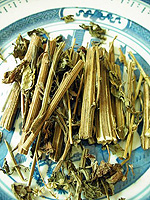 Diverse wormwood herb |
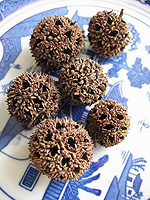 Sweetgum fruit |


